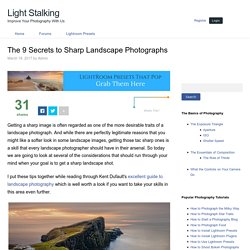

How to FIX WIDE ANGLE SHRINKAGE Fast in Photoshop! — MARK DENNEY. How many of you can relate to this scenario? You encounter a scene that really grabs your attention, it has all the elements you look for in a great composition - spectacular foreground that works the eye towards the mid-ground which in turn leads the viewer towards a majestic mountain range in the background. You grab your wide angle lens to capture the entire scene, click the shutter, review the image - you couldn’t be happier with the results. You arrive back home, load the image on your computer, but somethings off, the image lacks the grandiose quality that first caught your attention. Mark Denney. In this episode "5 Signs You're PROGRESSING in PHOTOGRAPHY" I discuss the power of recognizing personal improvement.

Photography in the digital age can feel very temporary as the majority of the images created are posted on social media and eventually slide off into the digital archives rarely to be seen again. We tend to only see what we've created in recent months and when we do this we're not able to appreciate and recognize how we're progressing. Are Long Telephoto Lenses For Shooting Landscapes? You Bet.
10 Landscape Photography Tips: Beginner and Advanced. 10 Tips and Tricks for the Beginner 1.

Shoot close to sunrise and sunset to achieve more balanced exposures. Shooting during the harsh daylight produces very contrasty light, and it’s difficult to capture details in both the shadow and highlight areas. The 10 laws of landscape photography. Landscapes can be one of the easiest of all photographic subjects.

Wide Angle Photography Hints And Tips. As a landscape photographer, wide-angle and ultra wide lenses simply cannot be ignored.

The most common error made when using wide-angle lenses is simply using them solely for their wide-angle, by just trying to get everything into the shot. The resulting picture often simply has too much in it, and the subject is just lost in amongst everything else. Really, you should consider a wide-angle lens not as a way to get more into the picture, but as a way of emphasising foreground detail and perspective.
In use, in a landscape situation, select your viewpoint carefully, as well as your foreground detail, and if possible, ensure that foreground element relates directly to the landscape and has a degree of shape harmony with the picture. If, for example, you choose a rock near the side of a lake on a calm day with reflections, ensure the rock is positioned to fit into the shape of the reflections. Photos By John Gravett. Use This Quick Checklist Before Every Landscape Photo. Gmail - Free Storage and Email from Google.
Photographing autumn colors, foliage and reflections. Bite Size Tips: How to Photograph Amazing Sunsets. 500px ISO » Beautiful Photography, Incredible Stories…8 Post-Processing Tips For Creating Beautiful Landscape Photos - 500px ISO. Jimmy Mcintyre is a travel photographer and educator.

His photos have been published in local and national magazines, including the BBC.
Alex Wise Photography. My name is Alex and I’m photographer originally from Tasmania, a beautiful and diverse island off mainland Australia.

When I’m not working my regular day job, I’m out exploring locations around my new home, Melbourne, Australia a stunning city that is home to some equally stunning landscape and seascape locations. This blog provides a log of my trips around Victoria (and occasionally returning home to Tasmania) and photography tutorials when I can. I’d love to give you a cheesy story about how I picked up a camera as a kid and was instantly hooked but in reality, photography came to me by luck in 2005 when I needed a film camera for school.
It wasn’t until 2006 when I purchased a Canon 350D that I became hooked thanks to the instant gratification of digital photography. My photography is self-taught and is constantly inspired by amazing photographers such as Peter Dombrovskis, Galen Rowell, Kah Kit Yoong, Thomas Leong, Denis Olivier and many more. Gear Articles. The 9 Secrets to Sharp Landscape Photographs. Getting a sharp image is often regarded as one of the more desirable traits of a landscape photograph.

And while there are perfectly legitimate reasons that you might like a softer look in some landscape images, getting those tac sharp ones is a skill that every landscape photographer should have in their arsenal. Zooming in for Creative Landscape Photography, with a Telephoto! Using a telephoto in your landscapes might seem…odd?

We often think of the wide angle lens as being the weapon of choice for the experienced landscape photographer. This may often be the case but any landscape photographer worth his salt will have a telephoto lens in his kitbag too, be it a zoom or prime. To newcomers, shooting landscapes with telephotos might seem like a strange concept, but it’s really not. Let me explain. Landscapes are not just about capturing majestic scenery in its entirety but also about isolating details within those scenes. Image by Sasin Tipchai. Aerial Perspective - The depth your images have been consciously missing. Something I’m going to be touching on today is referred to in the painting world as “Aerial Perspective”, a way, if not “the” way to create depth in your images.

When you see pictures of mountains, or landscapes you’ll often notice that they are coated with fog, clouds, smoke, steam, etc in order to make the background appear further away. Why does this work? Well from my understanding this works based on the ideology of imitating the atmosphere in real life where pollution, particles, water etc etc all get in the way over a long distance and create this “fading out” effect. So what if you don’t shoot landscapes? How does this appeal to those of us in the portrait or conceptual / fine art / composite world? Capturing the Golden Hours: How to Photograph Sunrises & Sunsets (VIDEO) Everyone reading this has likely shot a sunset in their lifetime.

And if you don’t mind getting up early, you’ve probably tried to capture a sunrise too. But how many of your images of sunrises and sunsets are truly exceptional? Go DARK to create fantastic moody photos. In photography, we’re often told that the ideal exposure is one that creates a bell-shaped histogram, smack dab in the middle of the tonal range, with a good balance of darks, mids, and brights. Even when post-processing, the general rule of thumb seems to be to keep the histogram right between the uprights; boost the shadows and pull down the highlights to create a balanced histogram, add some contrast and saturation, and voila! While this approach has led to millions of beautiful photos, what happens if it doesn’t suit the mood you’re going for? Let me suggest an easy approach to add mood to your photos… In post-processing, decrease the image’s exposure, then use the highlights slider, whites slider, tone curve, and/or dodging feature to increase the brightness of the photo’s highlights.
Amazing Sunset Photography. 50 Things You Need to Remember When Shooting a Landscape Photograph. Landscape is one of the great tests of the photographer. How to Average Layers In Photoshop. Enhance! A Practical Superresolution Tutorial in Adobe Photoshop. In this tutorial Ian Norman shows us how to enhance the resolution of a camera sensor with a technique called superresolution. With this technique, it’s possible to mimic the sensor-shift high-resolution mode found on cameras like the Olympus OM-D E-M5 Mark II to squeeze more megapixels out of the camera sensor. In his example, he increases the resolution of a 24 megapixel photo to more than 90 megapixels. See the full write-up and video walkthrough in this tutorial. We’ve seen it in plenty of thriller/crime solver TV shows and movies: upon reviewing some grainy and very low-resolution surveillance footage, someone inevitably asks the technician, “can you zoom in on that and enhance it?”
Then, with the quick press of a few masterfully placed keystrokes and bleepy computer sounds, the image is suddenly enhanced with vastly increased resolution and a key plot device is revealed. But there actually is a practical means of increasing the spatial resolution capability of a camera. How to Choose the Sharpest Aperture. Photographers have a dilemma. If you want your photographs to have the largest possible depth of field – from the foreground to infinity – a small aperture is absolutely necessary. At the same time, though, a small aperture causes your photograph to lose sharpness from diffraction. So, where’s the sweet spot?
In this article, I will cover how to choose the sharpest possible aperture for such a photograph, including mathematically accurate charts (free for printing) that are easy to use in the field. Before that, though, please note that this article only applies if you want everything from the foreground to the horizon (infinity) to be sharp in your photographs. A large portion of this article is simply the background research and calculations that went into the finalized charts. 5 Advanced Techniques to Show Every Detail in Your Landscape Photos. 7 Powerful Photography Tips for Amazing Photos by Joshua Cripps. Photo Cascadia Blog. Landscape photographers are increasingly turning toward more interpretive modes of presentation in order to express their own ideas about the scenes that they encounter. New techniques in field work and related digital processing have fueled this development, often enabling photographers to produce images that were nearly impossible to achieve in the film era.
These techniques address a plethora of age-old problems in landscape photography, from displaying a vast depth-of-field to escaping the constraints of shutter speeds and fixed angles of view. How to Take Good Sunset Photos. Hyperfocal Focus – How to Use It To Make Sharper Images! Alpenglow on Mt. Whitney, Alabama Hills, Eastern Sierra, California.
Sony a7RII, Sony 70-200mm, f/16, 2 seconds, ISO 100, Singh-Ray LB Polarizer. Landscape Photography Tips. 11 Surefire Landscape Photography Tips. 5 Key Tips to Improve Your Landscape Photography. B+W ND 110 filter exposure chart. I just stumbled upon this very interesting site while surfing the net in order to get some information about the B+W 110 (3.0) 10 stop filter. Just a few weeks ago, I came across some photos taken with this B+W 110 filter and was almost blown away!... How to Take Really Long Exposures with a DSLR. Hyperfocal Distance Explained. How to master depth of field for landscape photography. Maximizing Depth of Field Without Diffraction. Maximize your depth of field using the hyperfocal distance. Expert guide to minimalist photography.
32 Shooting & Planning Tips To Instantly Improve Your Landscape Photos - Shutter...Evolve.